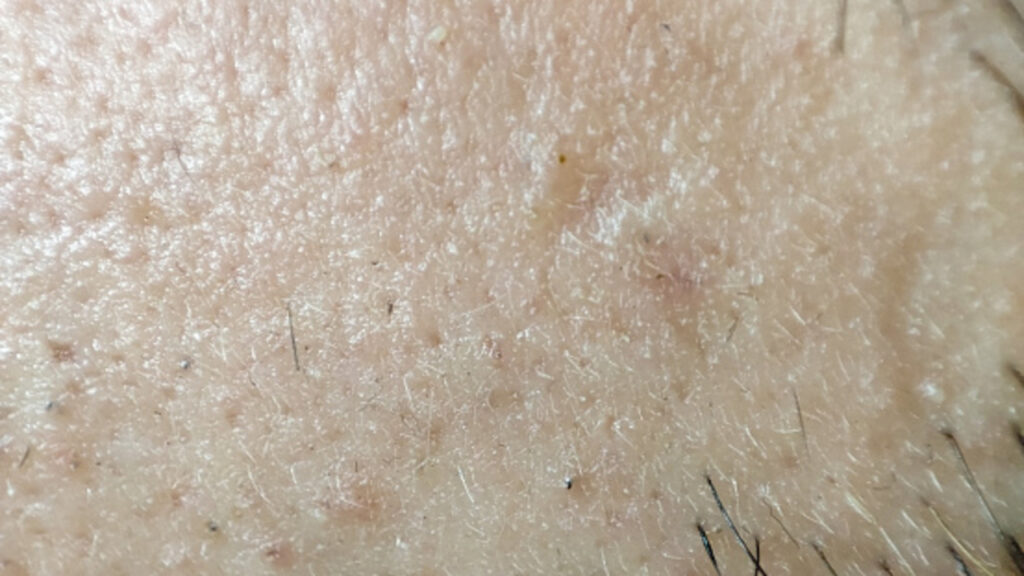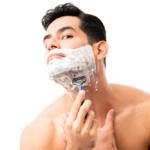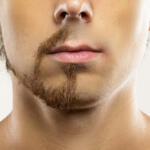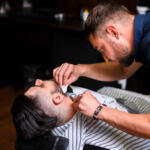
Do you struggle with ingrown hair after shaving? If so, you’re not alone. Ingrown hairs can be an annoying and sometimes painful problem that many people face. Fortunately, there are some simple steps you can take to help prevent ingrown hairs from occurring in the first place!
Table Of Contents
−- Prevention Tip 1: Exfoliate and Cleanse Before Shaving
- Prevention Tip 2: Use a Sharp Razor
- Prevention Tip 3: Use a Shaving Cream or Gel
- Prevention Tip 4: Shave in the Direction of Hair Growth
- Prevention Tip 5: Shave with Warm Water
- Prevention Tip 6: Apply Cold Water or Witch Hazel After Shaving or Waxing
- Prevention Tip 7: Moisturize
- Prevention Tip 8: Try an Ingrown Hair Serum
- Prevention Tip 9: Avoid Going Over the Same Area Too Often
- Prevention Tip 10: Avoid Tight Clothing
- Prevention Tip 11: Use a Cleanser with Salicylic Acid
- Prevention Tip 12: Avoid Irritants
- Conclusion
This post will discuss ways to prevent ingrown hairs from occurring after shaving your face, so you can avoid treating ingrown hair.
We will look at tips to exfoliate and cleanse your skin before shaving, use a sharp razor, shave in the direction of hair growth, and apply cold water or witch hazel after shaving or waxing.
We will also cover the importance of moisturizing, using an ingrown hair serum, avoiding tight clothing, using a cleanser with salicylic acid, and avoiding irritants. So let’s get started!
Prevention Tip 1: Exfoliate and Cleanse Before Shaving
To prevent ingrown hairs, it is essential to exfoliate and cleanse your skin before shaving. Gently exfoliating the area with a mild face wash can help remove any dead skin cells blocking the hair follicle, which can lead to ingrown hairs.
Not only will this help to prevent ingrown hairs, but it can also help to reduce irritation, razor burn, and shaving nicks. For an even deeper cleanse, you can use a cleanser that contains glycolic or other alpha-hydroxy acids, as these will help to loosen the skin and open up the pores.
It is also important to use a cleanser that is suitable for your skin type. For example, those with dry or sensitive skin should use a gentle cleanser with moisturizing ingredients, while those with oily or acne-prone skin should opt for a cleanser that contains salicylic acid or benzoyl peroxide.
Prevention Tip 2: Use a Sharp Razor
Using a sharp razor is important in preventing ingrown hairs after shaving. A dull razor can cause irritation, increase the risk of infection, and increase the likelihood of ingrown hairs. Investing in a quality razor that will stay sharp longer and minimize the need for frequent sharpening is best.
For best results, it is recommended to replace your razor blade after five uses or when it begins to feel dull. Furthermore, use a shaving cream or gel to lubricate the skin and protect it from unnecessary irritation.
Make sure to store it in a dry place away from moisture, as exposure to moisture can also cause it to become dull. You should also replace the blade often, as a dull blade can cause skin irritation and ingrown hairs.
Prevention Tip 3: Use a Shaving Cream or Gel
Using a shaving cream or gel is important to prevent ingrown hairs. Shaving gel helps to create a protective layer between your skin and blade, providing lubrication to avoid irritation. This can help reduce the risk of razor burns, cuts, and ingrown hairs.
Additionally, shave gel allows the razor to glide more easily over the skin, preventing it from pulling or tugging on the hair. When selecting a shaving gel or cream, look for one specifically designed for sensitive skin and contains moisturizing ingredients like shea butter or aloe vera that help soothe and hydrate the skin.
Prevention Tip 4: Shave in the Direction of Hair Growth
Shaving in the direction of hair growth is important in preventing ingrown hairs. When shaving your face, legs, or any other body part, it’s important to remember to always go with the grain. Doing this helps to ensure that the razor is catching all of your hair and not just some of it, which can lead to ingrown hairs.
Additionally, it helps reduce irritation and discomfort during and after shaving. To ensure you are going in the right direction, check which way your hair grows before you start.
Prevention Tip 5: Shave with Warm Water
Warm water is a great way to help prepare your skin for shaving. It helps to soften the outer layer of skin, making it easier to remove hair and decreasing the chance of ingrown hairs. Before shaving, spend about 10 minutes in warm water to help soften the skin.
This can be done in the shower or by soaking a towel in hot water and applying it to the area you are going to shave. Additionally, warm water can be used while shaving by rinsing off the razor blade frequently.
Using warm water during shaving will help keep hairs hydrated and reduce friction, resulting in a closer shave and less irritation.
Prevention Tip 6: Apply Cold Water or Witch Hazel After Shaving or Waxing
Cold water or witch hazel can help reduce irritation and tighten your pores, making it harder for bacteria to settle in and cause infection.
Witch hazel is also a natural antiseptic that can be applied a few hours after hair removal to prevent infection further. Applying either of these liquids immediately after shaving can help to soothe the skin and prevent any further irritation or discomfort.
Prevention Tip 7: Moisturize
After shaving or waxing, moisturize the skin to reduce irritation and prevent ingrown hairs. Moisturizing helps keep the skin hydrated and supple, which in turn helps to prevent hairs from getting trapped under the skin.
Look for a moisturizer formulated for sensitive skin with natural ingredients that can soothe and nourish your skin. Consider using an aloe-based balm or an oil-based serum for an extra boost. You can also apply a cold compress after shaving or waxing to help reduce swelling and redness. Taking care of your skin is key to avoiding ingrown hair pains and irritation.
Prevention Tip 8: Try an Ingrown Hair Serum
Ingrown hairs can be a frustrating problem, but luckily there are ways to prevent them. One of these methods is to try an ingrown hair serum. These serums are specially formulated with natural ingredients such as tea tree oil and salicylic acid to reduce redness, inflammation, and irritation associated with ingrown hairs.
They also help to soften the skin and loosen the trapped hair follicles, allowing for easier removal. Applying an ingrown hair serum regularly can significantly reduce the incidence of ingrown hairs and provide long-term relief from the discomfort of this condition.
Prevention Tip 9: Avoid Going Over the Same Area Too Often
When shaving, it’s important to avoid going over the same area too often. This can irritate and lead to an increased risk of ingrown hairs. If you need a closer shave, try using a new razor or switching directions when you shave. Taking your time and reviewing the area can help prevent razor burns, bumps, and ingrown hairs.
Prevention Tip 10: Avoid Tight Clothing
Avoiding tight clothing is an important step in preventing ingrown hairs. Tight clothing can suppress the hair follicles and cause them to become embedded in the skin, resulting in an increased risk of ingrown hairs.
The best way to prevent this is to wear loose-fitting clothing, especially around the pubic area. This will ensure that the hair follicles are not suppressed and can grow freely without becoming embedded in the skin.
Additionally, it is important to change out of tight clothing as soon as possible after shaving or waxing to reduce the risk of ingrown hairs.
Prevention Tip 11: Use a Cleanser with Salicylic Acid
Applying a cleanser with salicylic acid is an effective way to prevent ingrown hairs after shaving. Salicylic acid helps reduce inflammation and redness caused by ingrown hairs and open clogged pores and follicles. This can help stop the hair from becoming trapped under the skin before it even has a chance to grow.
For best results, look for a product specifically designed to treat ingrown hairs, such as one that contains 2% salicylic acid. It’s also important to follow the instructions on the product packaging and seek advice from a dermatology provider if needed.
Prevention Tip 12: Avoid Irritants
It is important to avoid irritating products or ingredients when shaving or waxing to prevent ingrown hairs. Irritants could be anything from fragranced soaps and lotions to ingredients like alcohol, menthol, and witch hazel.
Avoiding these can help reduce irritation and inflammation. Make sure to read the labels of any products you are using and avoid any that contain irritating ingredients. Additionally, it is important to avoid tight clothing around the areas that have been shaved or waxed, as this can also cause irritation and discomfort.
Conclusion
Concluding, taking the proper steps before, during, and after shaving is the key to preventing ingrown hairs.
By exfoliating and cleaning your face before shaving, using a fresh and sharp razor, shaving with a damp face in the direction of hair growth, applying cold water or witch hazel after shaving, and moisturizing afterward, you can help avoid razor bumps and ingrown hairs.
Use a shaving cream or gel to give you extra protection against irritation. Additionally, avoid going over the same area too often to help keep your skin healthy.
Last update on 2024-04-25 / Affiliate links / Images from Amazon Product Advertising API
Affiliate Disclosure: This post contains affiliate links, which means I may receive a small commission, at no extra cost to you, if you make a purchase using these links.

Jay Kang
Just because i'm asian does not mean I don't need shaving. I always wanted to grow a beard when I was young, now I need to shave because hair growth for me is a problem. I'm going through what every man will and has gone through before.











